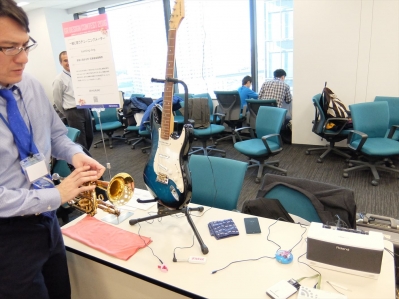Title:Singing Tuning Meter
Displayed Name:hamling-ling

| Concept / Overview |
|---|
| This gadget uses GR-KURUMIand generates a melody or scales by midi-over-BLE, sourcing from the notes played by the user.While listening to the notes emitted by the gadget, the user can tune their own instrument by ear. |
The idea behind the gadget & happy users
Idea:
To create a compact tuning meter ensuring that notes produced by your music instrument emit the correct musical intervals.
In order to ensure that one’s notes are on key, one must be able to hear them accurately in one’s own head. The proposed gadget would train users to hear the correct notes, remember them, and reproduce them accurately.
Users would need to wear this gadget while playing their instrument. It therefore would need to be both compact and cordless. The volume would need to be such that it did not drown out notes produced by the user. It would not feature earphones, as they would prevent the user from hearing sound produced by him- or herself.
Happy Users:
Amateur wind and string instrument musicians. Students in brass band clubs.
Results Achieved as of Contest Judging
A system operating in sequence: pick-up microphone – pitch detector (fixed-point FFT, etc.) – BLE module – smartphone – speaker.
Pitch detection would encompass volume and frequency range (440Hz to one octave above and one below).
No temperature compensator.
Demo Video
Overview and Instructions
Overview
The GR-KURUMI 16-bit MCU board is used to create an electronic gadget reproducing the sounds created by the user via midi over BLE. When the user hears the sound produced by midi, they can correct their own pitch, “tuning” the instrument by ear.
How to Use the Gadget
- Connect a microphone designed for tuners (YAMAHA TM-20WH, etc.) to Kurumi Tuner.
- Connect the BLE Midi Receiver (YAMAHA UD-BT01, etc.) and the power source to the Midi device.
- Turn on the BLE Midi Receiver and Kurumi Tuner and wait until the start-up sound (do-re-mi notes) become audible.
- Play the instrument and ensure that the midi is capturing the sounds.
- Play Beethoven’s 5th Symphony and switch to tuner mode (see video)
- When the user’s pitch is too high, a triangle will ding; when it is too low, a drum will sound. A perfect pitch will be rewarded by cymbals crashing.
Video:
https://youtu.be/ZwmfuGoQjK4
Schematics:
https://easyeda.com/normal/KurumiBleTuner-9dca205233fa403bbf2e9ca330b25814
Source code:
https://github.com/hamling-ling/KurumiBleTuner
Procedure
GR DESIGN CONTEST 2016 Finalist

